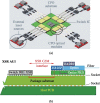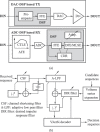Co-packaged optics (CPO): status, challenges, and solutions
- PMID: 36939942
- PMCID: PMC10027985
- DOI: 10.1007/s12200-022-00055-y
Co-packaged optics (CPO): status, challenges, and solutions
Abstract
Due to the rise of 5G, IoT, AI, and high-performance computing applications, datacenter traffic has grown at a compound annual growth rate of nearly 30%. Furthermore, nearly three-fourths of the datacenter traffic resides within datacenters. The conventional pluggable optics increases at a much slower rate than that of datacenter traffic. The gap between application requirements and the capability of conventional pluggable optics keeps increasing, a trend that is unsustainable. Co-packaged optics (CPO) is a disruptive approach to increasing the interconnecting bandwidth density and energy efficiency by dramatically shortening the electrical link length through advanced packaging and co-optimization of electronics and photonics. CPO is widely regarded as a promising solution for future datacenter interconnections, and silicon platform is the most promising platform for large-scale integration. Leading international companies (e.g., Intel, Broadcom and IBM) have heavily investigated in CPO technology, an inter-disciplinary research field that involves photonic devices, integrated circuits design, packaging, photonic device modeling, electronic-photonic co-simulation, applications, and standardization. This review aims to provide the readers a comprehensive overview of the state-of-the-art progress of CPO in silicon platform, identify the key challenges, and point out the potential solutions, hoping to encourage collaboration between different research fields to accelerate the development of CPO technology.
Keywords: Advanced packaging; Co-packaged optics; Co-simulation; External laser; High-performance computing; Optical power delivery; Receiver; Silicon photonics; Standardization; Transmitter.
© 2023. The Author(s).
Conflict of interest statement
The authors declare that they have no competing interests.
Figures


























References
-
- Mahajan R, Li X, Fryman J, Zhang Z, Nekkanty S, Tadayon P, Jaussi J, Shumarayev S, Agrawal A, Jadhav S, Singh KA, Alduino A, Gujjula S, Chiu CP, Nordstog T, Hosseini KJ, Sane S, Deshpande N, Aygun K, Sarkar A, Dobriyal P, Pothukuchi S, Pogue V, Hui D. Co-packaged photonics for high performance computing: status, challenges and opportunities. J. Lightwave Technol. 2022;40(2):379–392. doi: 10.1109/JLT.2021.3104725. - DOI
-
- Kumar, A., Chang, L., Tellez, G., Clevenger, L., Burns, J.: System performance: from enterprise to AI. In: Proceedings of 2018 IEEE International Electron Devices Meeting (IEDM). pp.28.1.1–28.1.4 (2018)
-
- Siegl, P., Buchty, R., Berekovic, M.: Data-centric computing frontiers: a survey on processing-in-memory. In: Proceedings of the Second International Symposium on Memory Systems. pp.295–308 (2016)
-
- Maniotis P, Schares L, Lee BG, Taubenblatt MA, Kuchta DM. Toward lower-diameter large-scale HPC and data center networks with co-packaged optics. J. Opt. Commun. Netw. 2021;13(1):A67–A77. doi: 10.1364/JOCN.402676. - DOI
-
- Minkenberg C, Kucharewski N, Rodriguez G. Network architecture in the era of integrated optics. J. Opt. Commun. Netw. 2019;11(1):A72–A83. doi: 10.1364/JOCN.11.000A72. - DOI
LinkOut - more resources
Full Text Sources
Miscellaneous

